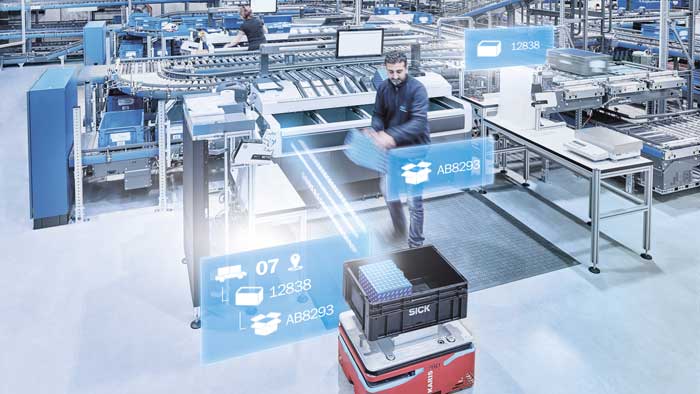Complexity has a major impact on the processes of order picking, transmission, tracking, as well as on the processing of goods. This calls for increasingly flexible and modular intralogistics methodologies and technologies. Flexibility can be achieved through interconnection, which in turn can be enabled through the implementation of sensors.
H2: Sensors for intralogistics
The market today offers a wide range of sensors depending on the precision and the speed required: 2D laser scanners, 3D camera systems, line guidance sensors and tag-based localization systems, just to name the main ones.
The sensors enable the automatic identification and localization of products, thus generating strategic information for the analysis and diagnosis of critical issues. Digitalization thus becomes real and tangible.
Different types of sensors for specific tasks can be implemented within intralogistics processes. Some examples are:
- Object volume measurement
- Recognition of empty containers
- Edge detection
- Precise positioning on the lifting and movement unit
- Automatic product identification
- Shelf occupancy contro
- Container sorting
H2: Data value
An
integrated sensor system makes it possible to detect and analyse large amounts of data. It is therefore necessary to adopt analysis platforms capable of transforming data into added value. An example in this direction is
Asset Analytics, SICK's
solution for generating a real-time overview of sensor data.
Through the platform it is possible to obtain a representation of motion profiles, the analysis of downtime and transport times and process optimization profiles. It is also possible to manage events individually and set up user-defined automated actions via SMS or e-mail. The result is the creation of reliable, repeatable, and predictable cycles of the entire material flow.
H2: Analysis and monitoring
Analysing the health status and assessing the criticality of the system must be an integral part of a holistic approach to intralogistics technology.
One example is the monitoring and diagnostics software
Package Analytics by SICK. The
platform is able to easily retrieve and analyse information on system performance and the status of all tracked data, from a single package up to the total volume handled over a day. This makes it possible to generate reports and access the most important
variables in real time.
H2: Self learning
Artificial intelligence today represents the state-of-the art in technological innovation. In 2023, an efficient logistics hub cannot do without the integration of machine learning algorithms. SICK has implemented deep learning algorithms and technologies into the sensors. Through self-learning it is possible to carry out process optimization with an unprecedented level of precision. In intralogistics, vision sensors for deep learning allow the automatic recognition, analysis, classification, and localization of objects through the evaluation of a dataset of images. SICK sensors can capture and evaluate the characteristics of the packages to highlight anomalies - such as dents or damages - or to determine the nature of the packages.
H2: Autonomous systems
Self-driving vehicles are now a reality within large logistics centres. Their efficiency, flexibility and safety features represent an added value that can make the difference. In this area, SICK has developed a modular ecosystem with sensor solutions developed according to handling requirements.
The detection of packages during loading and unloading can be configured quickly and effectively for all types of goods. The integration of LiDAR sensors and cameras enables the recognition of any obstacles along the way, thus maximizing safety.


